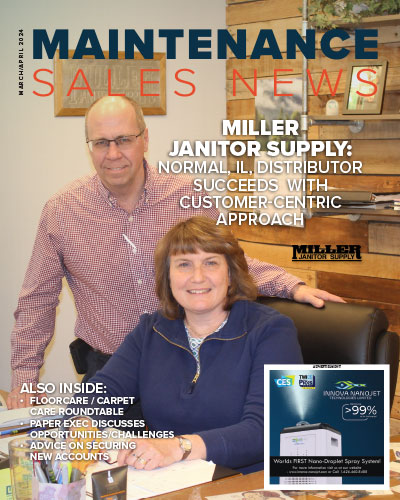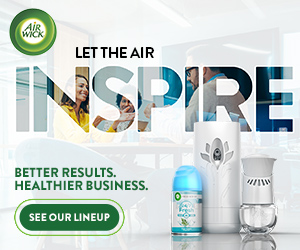The Proper Care Of Commercial Carpet In High Traffic Areas
By Ronnie Brown BSIT MTC, Contributor
Carpet in a commercial setting has many benefits — noise reduction, indoor air quality and safety to name a few. While carpet may be a great choice for commercial environments, it also comes with its own challenges. Most notably, proper care and maintenance to ensure that it is contributing to indoor air quality, remains aesthetically pleasing and lasts for as long as possible.
So, what does a proper care and maintenance program consist of? According to the CRI (Carpet and Rug Institute), a customized comprehensive carpet care program consists of five elements:
- Soil Prevention;
- Routine Vacuuming;
- Routine Spill, Spot, and Stain Removal;
- Interim Maintenance Cleaning; and,
- Deep Cleaning.
Soil prevention consists of keeping the outside soil out. This is accomplished by regular cleaning/sweeping of sidewalks and parking lots. It is also necessary to contain soil that makes its way inside. This is why walk off mats are so important. Much of the soil tracked inside buildings is walked off in three or four steps and this translates to ten to twelve feet. Coupling outside mats with inside mats and extending twelve feet or so, will go a long way in preventing soil from ever reaching the carpet.
Regular, routine vacuuming is absolutely necessary in prolonging the useful life of any carpet, especially in commercial environments. Sand is an enemy of carpet; it is so abrasive that it can cut and damage even the best carpet yarn. A commercial vacuum or pile lifter should be used to ensure proper suction and agitation. Main entries, reception areas, elevators and other very high traffic areas should be vacuumed daily. Less used areas may be vacuumed two or three times per week.
An effective Routine Spill, Spot, and Stain Removal System is essential in prolonging the life of commercial carpet. The longer any spot or spill remains in the carpet the greater the chance of it becoming permanent. There are a variety of spotters that are effective at removing common spots and spills and maintenance staff should be properly trained in their use. An important part of training should include the safe use and handling of all spotting chemicals. Some of the essentials of a maintenance spotting kit should include:
- Neutral spotter;
- Alkaline spotter;
- Tannin/Acid spotter;
- NVDS – Non-Volatile Dry Spotter;
- VDS – Volatile Dry Spotter; and,
- Aerosol gum freezing spray.
It is important to understand that many of these spotters must be neutralized and rinsed from carpet to avoid leaving a residue which may attract soil and create a new spot. Correct spotting procedures must be understood so that chemical overuse and damaging agitation is avoided.
This is certainly not an exhaustive list. There are many additional spotting chemicals that may be useful in various situations, but this list will help to address common spots and spills.
The purpose of Interim Maintenance Cleaning is to keep the carpet looking good between deep cleanings. The frequency of interim cleaning depends on several factors including the amount of foot traffic, the color and type of yarn, and the type of soil that is tracked onto the carpet. For example, an Olefin (Polypropylene) fiber, combined with a newly re-coated parking lot, will require more frequent cleaning than a nylon fiber. This is due to Olefin’s affinity for oil including petroleum products like asphalt. Interim maintenance may be accomplished with a variety of methods and equipment including:
- Absorbent Compound – Machines with a cylindrical or counter rotating brushes agitate the moistened compound into the carpet. The compound is then extracted with a commercial vacuum.
- Absorbent Pad – 175 RPM floor machines or oscillating machines with pads are used to agitate the pre-sprayed carpet and collect soil through absorption and adsorption.
- Encapsulation – An encapsulating solution is applied to the carpet and a CRB, oscillating or rotary machine is utilized to agitate and suspend soil. The soil is then encapsulated in the solution upon drying. The encapsuled crystals or flakes are removed with a commercial vacuum.
- Foam – After a low residue foaming agent is applied, it is agitated with brushes into the carpet. Some systems produce hot foam, which aids in suspending soil. The foam can be vacuumed with a wet vac immediately or upon drying, it can be extracted with a commercial vacuum.
- Water Extraction – Detergent is applied to the carpet, then agitated into the carpet manually with a carpet rake or with a walk behind commercial carpet machine. Walk behind machines apply cleaning agents, agitate then flush and extract the soil. A portable carpet extractor may also be utilized to perform the rinsing and extraction.
One of the benefits of the interim methods is that some of them tend to leave the carpet in a more dry condition. This may allow the carpet to be returned to full use in a shorter period of time.
According to the IICRC (Institute of Inspection Cleaning and Restoration Certification) deep or corrective cleaning is utilized “to return the carpet to a relatively clean condition and uses systems that rinse out or extract out accumulated soils and cleaning residues at a higher intensity to maximize removal of embedded soils.” The most effective deep cleaning method is Hot Water Extraction. The most powerful and effective equipment utilized for HWE is the truck mounted cleaning machine. Some of the interim maintenance processes will leave the carpet in a more dry condition, but none can provide deep, restorative cleaning like the truck mounted system. The best truck mounted machines can generate high water temperatures (200+ degrees f), high vacuum (13+ Hg) and air flow (400+ CFM) and sustained water pressure (475+ psi). These systems are excellent at flushing away soil and residue, even previous cleaning residue.
Deep corrective cleaning will take a little longer to dry than most of the maintenance methods, so it is usually done after normal operating hours.
Commercial carpet that has a maintenance plan in place and addresses the requirements above, will look great and last for many, many years. A saying in carpet cleaning circles goes like this: “Carpet uglies out before it wears out.” Following approved processes and procedures by the CRI and IICRC will keep the “ugly” away for years to come.
Clean Zone Carpet and Upholstery Care LLC (www.cleanzoneclean.com) was started by Ronnie Brown (ronnie@cleanzoneclean.com) and his wife, Anita Brown, in 1997. Their goal is to help make the indoor environment healthier while cleaning and maintaining textiles. Ronnie has been an IICRC Master Textile Cleaner for over 20 years and is taking the final steps to becoming an IICRC instructor. Services offered: Carpet cleaning; upholstery cleaning; rug cleaning; tile and grout cleaning; natural stone honing, polishing, restoring; hardwood cleaning/polishing; and, LVP cleaning.








